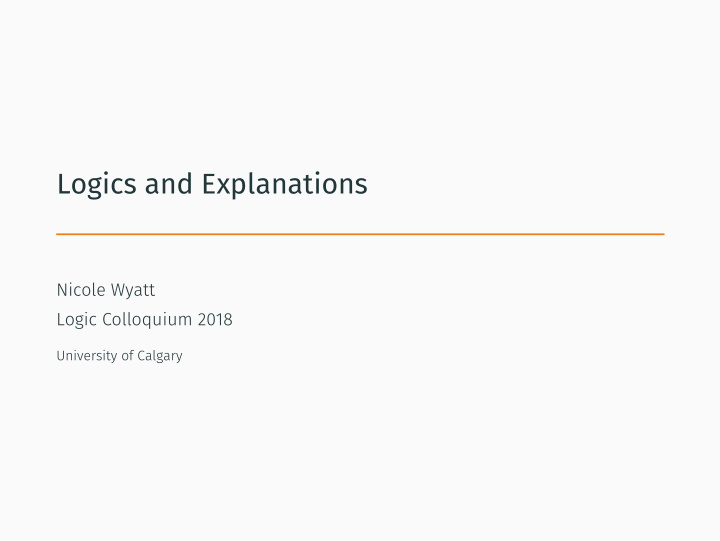



Logic Colloquium 2018 Nicole Wyatt University of Calgary Logics and Explanations
This talk draws on prior joint work with Gillman Payette, especially Nicole Wyatt and Gillman Payette. “Logical Particularism”. In: Pluralisms: Truth and Logic . Ed. by Nathan Kellen, Nikolaj J. L. L. Pedersen, and Jeremy Wyatt. Forthcoming. 2 Nicole Wyatt and Gillman Payette. “How Do Logics Explain?” In: Australasian Journal of Philosophy 96.1 (2018), pp. 157–167 and
Logics and Natural Language
4 Relationship?
5 Monism
6 Pluralism
7 Nihilism
Woody and Scientific Explanation
[B]ecause explanatory discourse inculcates particular patterns of reasoning, it functions to sculpt and subsequently perpetuate communal norms of intelligibility. In effect, explanations encode the aims and values of particular scientific communities, telling practitioners what they should want to know about the world and how they should reason to get there. Andrea I. Woody. “Re-Orienting Discussions of Scientific Explanation: Science Part A 52 (2015), pp. 79–87, p. 81 9 Functional Approaches to Explanation A Functional Perspective”. In: Studies in History and Philosophy of
... [the] reasons have to do with the task of explaining. ... we have to decide what kinds of factors can be cited in explanations. One thing that ceteris paribus laws do is to express our explanatory commitments. They tell what kinds of explanations are permitted Press, 1983, pp. 47-48. 10 Cartwright Nancy Cartwright. How the Laws of Physics Lie . Oxford University
11 Ideal Gas Law
Logics as explanatory frameworks
• abstraction • contrastive explanation • counter-factual reasoning • explanatory scaffolding 13 Features of ‘false’ models in science
Abstract mathematical models in ecology overcome two obstacles for studying real systems: a) the time scale on which they operate tends to exceed the time available for study, and b) their complexity makes it difficult to manipulate them systematically. Jay Odenbaugh. “Idealized, Inaccurate but Successful: A Pragmatic and Philosophy 20.2-3 (2005), pp. 231–255 14 Abstraction Approach to Evaluating Models in Theoretical Ecology”. In: Biology
Galileo’s theory of falling bodies predicts that all bodies will fall at the same speed. Of course that is not what we observe in the actual world. But Galileo’s theory allows us to explain why in our world anvils fall faster than feathers precisely via attention to the unrealistic assumption that falling happens in a vacuum. Galileo’s false model points us to the correct explanation—air resistance—and away from the incorrect one—mass. Philosophy of the Social Sciences 38.3 (2008), pp. 334–360, pp. 342-3. 15 Contrastive Explanation Frank Hindriks. “False Models as Explanatory Engines”. In:
Bohr’s model of the hydrogen atom, while fictional, allows us to answer a wide range of ‘what-if-things-had-been-different’ questions. There is a pattern of counter-factual dependence between the emission spectrum of hydrogen and the elements of Bohr’s model. 180.1 (2011), pp. 33–45 16 Counter-factual reasoning Alisa Bokulich. “How Scientific Models Can Explain”. In: Synthese
In chemistry, the ideal gas law provides allows chemists to conceptualize actual gas properties as deviations from the ideal, and thus unifies the treatment of all gases under a single false model. Andrea I. Woody. “How is the Ideal Gas Law Explanatory?” In: Science & Education 22.7 (2013), pp. 1563–1580; Andrea I. Woody. “Re-Orienting Discussions of Scientific Explanation: A Functional Perspective”. In: Studies in History and Philosophy of Science Part A 52 (2015), pp. 79–87. 17 Explanatory scaffolding
• abstraction • contrastive explanation • counter-factual reasoning • explanatory scaffolding 18 Features of ‘false’ models
• abstraction • contrastive explanation • counter-factual reasoning 18 Features of ‘false’ models • explanatory scaffolding
(C1) The marble is not big. A marble is selected at random and placed under a cup. Big Small Red 30 10 Blue 10 50 (P1) If the marble is big, then it’s likely red. (P2) The marble is not likely red. Seth Yalcin. “A Counterexample to Modus Tollens”. In: Journal of Philosophical Logic 6 (2012), pp. 1001–1024, p. 1002 19 Yalcin and Modus Tollens
A marble is selected at random and placed under a cup. Big Small Red 30 10 Blue 10 50 (P1) If the marble is big, then it’s likely red. (P2) The marble is not likely red. Seth Yalcin. “A Counterexample to Modus Tollens”. In: Journal of Philosophical Logic 6 (2012), pp. 1001–1024, p. 1002 19 Yalcin and Modus Tollens (C1) The marble is not big.
terms in terms of constraints on information states. • two different formal semantics for a language including as operators the conditional, ‘might’, ‘probably’, negation, and conjunction. • both invalidate cases of modus tollens involving the probability operators of the language while preserving the validity of other cases of modus tollens. • doesn’t account for some other cases of modus tollens failure involving alternative vocabulary 20 Yalcin’s solution • model the semantic values of sentences like probably- φ in
• both modus tollens and classical logic more generally (as well as the standard semantics which support them) are serving an explanatory role like the ideal gas law • the counterexample is not explained away • offers an account of the ‘problem’ cases in terms of deviations from the standard semantics • conforms to the expectation that logical explanation will be of the same kind as found in classical logic • offers an analysis of his counter-examples on which logics endorsing modus tollens can be seen as assuming the absence of probability operators. 21 Yalcin’s solution
22 Logics and natural language
23 THANK YOU
Recommend
More recommend